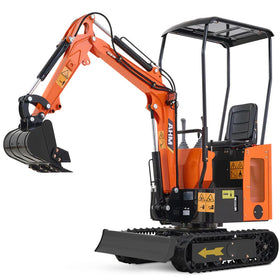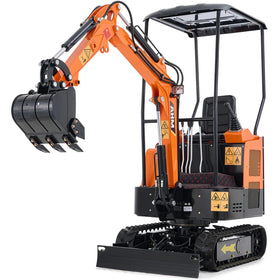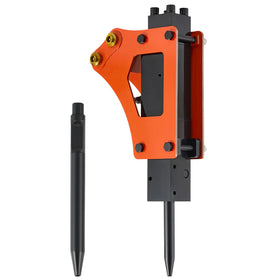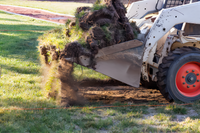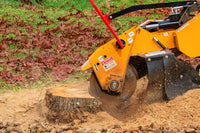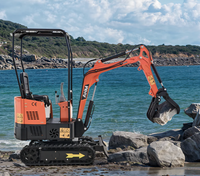The backhoe vs mini excavator debate isn't just about which one digs deeper or costs less. It's about matching the right tool to your specific job, site conditions, and budget constraints. Whether you're installing utilities, landscaping your property, or running a construction business, understanding the real differences between these machines will save you from making expensive mistakes.
Let's cut through the confusion and find out which machine actually makes sense for your project.

Backhoe vs Mini Excavator: The Main Differences
When comparing the capabilities of an excavator vs backhoe, the fundamental differences go way beyond just size. A backhoe combines a front loader bucket with a rear-mounted digging arm, creating a two-in-one machine, while mini excavators focus on precision digging and excavation with 360-degree rotation capability.
What Defines a Backhoe?
A backhoe loader combines tractor, loader, and excavator functionality into one machine. The typical backhoe weighs around 15,000-16,000 pounds and digs 13-15 feet deep with impressive breakout force.
Key characteristics include dual functionality with both the front loader and rear digger, wheeled mobility with rubber tires, limited 200-degree rotation, 20-100 HP engines, and a larger footprint that requires more space to operate.
What Makes Mini Excavators Unique?
Mini excavators are compact, tracked machines for precision work in confined spaces. They usually weigh 2,000-18,000 pounds and offer full 360-degree rotation.
Mini excavators are best for single-purpose digging work, move on tracks, have complete 360-degree swing capabilities, and a compact design for fitting through tight spaces and doorways.
When Backhoes are Best: Power and Versatility
The backhoe loader vs excavator decision favors backhoes for larger sites with varied work requirements. So, choose a backhoe if your project demands versatility to do multiple tasks throughout the day. For the following versatile digging tasks, you might want to consider a backhoe:
1. Material handling and transportation
A backhoe is great because the front loader moves sand, gravel, and debris efficiently across job sites while the rear arm handles excavation.
2. Landscaping and site preparation
The dual-arm design allows digging with the rear bucket while using the front loader for cleanup and material placement.
3. Utility installations on larger sites
Mobility and power advantages shine when projects span multiple acres or require frequent repositioning.
4. Agricultural work
Backhoes can handle everything from irrigation ditches to moving feed and clearing debris.
Though backhoes are better for the above tasks, it is not impossible to do them with a mini excavator. Landscaping with a mini excavator is entirely possible, as well as agricultural projects and utility installation.
Key Advantages of a Backhoe
- Multitasking capability lets skilled operators use both arms simultaneously.
- Road mobility enables travel between job sites without transportation costs.
- Superior lifting capacity from the larger size and higher horsepower.
- Weather resilience through a larger cab and robust design
Backhoe Limitations
- Higher operating costs ($25,000-$150,000 new, $45-$75 hourly operation).
- Limited precision for delicate work around utilities.
- Long-distance transportation requires heavy-duty trailers and CDLs.
- Struggles in shallow digging where accuracy matters more than power.
Explore the pros and cons of mini excavators in more detail.

Where Mini Excavators Dominate: Precision and Efficiency Applications
Choose a mini excavator when precision, tight-space access, and efficient digging are more important than material-handling or power.
4 Perfect Mini Excavator Applications
- Residential construction: Navigate tight spaces between houses and existing landscaping without damage.
- Utility trenching: Precision control and consistent depth capability, perfect for electrical, water, and communication lines.
- Landscaping projects: Water features, retaining walls, and precise grading benefit from 360-degree rotation and delicate control.
- Confined space work: Some models can work inside buildings and fit through standard doorways for basement excavation.
Explore this complete mini excavator digging guide for more project ideas
Key Mini Excavator Advantages
- Unmatched maneuverability with 360-degree rotation.
- Most can be transported easily in a trailer behind pickup trucks.
- Lower operating costs ($20,000-$100,000 new).
- Precision control allows millimeter-precise movements.
Mini Excavator Limitations
- Single-purpose design.
- Limited lifting capacity compared to backhoes.
- Slower on large-scale excavation projects.
- Terrain limitations on very rough ground.

Best Mini Excavators for Professional Applications
When your project calls for a mini excavator, choosing the right mini excavator model makes all the difference. AHM offers proven mini excavators delivering professional results at competitive prices.
1. AHM AX-12
Starting at $6,799.99, the AX-12 delivers exceptional value for contractors seeking a backhoe alternative, boasting a 73-inch maximum digging depth that's 12% deeper than competitors.
- It features a 2,227 lb operating weight for a perfect balance of stability and maneuverability
- A Briggs & Stratton 25T2 engine with a lifespan three times longer than the competition.
- The 3'1" width lets it fit through standard gates.
- Its 123.2-inch digging radius handles most residential and light commercial projects more efficiently than repositioning a backhoe multiple times.
This mini excavator is perfect for contractors transitioning from backhoe rentals, homeowners with substantial projects, and landscaping professionals working in residential areas.
2. AHM AX-16
Starting at $8,999.99, the AX-16 proves that mini excavators can deliver serious performance, rivaling backhoes.
- Its 23 HP dual-cylinder engine provides 70% more power than single-cylinder alternatives。
- It has a digging force of 3,262 lbf, which matches many backhoe specifications.
- It also features a 71-inch maximum digging depth, making it ideal for utility and foundation work.
The reduced tail swing design works in spaces where backhoes simply can't operate, while the advanced hydraulic system handles high-flow attachments, and the 1000mm adjustable dozer blade provides efficient backfilling capability, making it perfect for professional excavation contractors, utility installation specialists, and construction companies working in urban environments where backhoe limitations become problematic.
The Bottom Line: Making the Smart Choice
Ultimately, the backhoe vs mini excavator decision comes down to matching capabilities with project requirements and working conditions.
Choose a backhoe when you need versatile material handling, work on large open sites, require road mobility and handle diverse daily tasks.
Backhoes excel when power and multitasking matter more than precision. On the other hand, choose a mini excavator when precision digging, confined access, and transportation ease are priorities.
They are the go-to choice for working around existing structures, consistent trenching, and urban environments.
Stop second-guessing your equipment choices. Match your machine to your needs, invest in quality equipment, and discover how much more efficient projects become with the right tool for the job.
Here is a mini excavator size chart to guide you on what mini excavator size you need.


